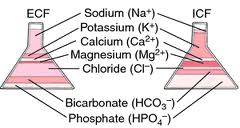Please Pass the Salt – or Not . . .
Let’s face it; there’s a lot of controversy about how much salt you should include in your diet.
In this article, we’ll discuss the reasons for the current low sodium recommendations, together with some opposing views, and some studies that show that a low sodium diet may not be right for everyone.
But before we present both sides, let’s take a quick look at the role of salt in your body.
Salt at the cellular level 
Water inside your body is both intracellular (inside your cells) and extracellular (surrounding your cells).
Did you know that every cell in your body swims in its own ocean of salt?
Extracellular water has a saline content similar to that of sea water, while intracellular water is held in your cells by potassium.
When you consume water, salt, and potassium from the foods you eat, you maintain a balance between them that helps promote good health.
Salt is integral to our health
The sodium and chloride in salt are electrolytes - minerals that conduct electricity in your body’s fluids and tissues. The other main electrolytes are potassium, calcium, and magnesium, along with bicarbonate, phosphate, and sulfate.
Electrolytes are important because they carry electrical impulses to your nerves and muscles.
 Your kidneys maintain the balance of electrolytes and water by regulating the fluids that you take in and pass out of your body. If this balance is disturbed, your muscles, nerves, and organs won't function correctly.
Your kidneys maintain the balance of electrolytes and water by regulating the fluids that you take in and pass out of your body. If this balance is disturbed, your muscles, nerves, and organs won't function correctly.
Sodium plays a critical role in your body’s functions. Too much or too little sodium can cause cells to malfunction. Extremes in the blood sodium levels (too much or too little) can even be fatal.
Have we learned all there is to know about sodium?
If it's so important, why do so many health organizations recommend that we closely watch our sodium intake?
The average person in the U.S. consumes more than 3,500 mg of sodium a day.
Current recommendations for salt intake are 2,300 mg sodium a day (approx 1 teaspoon salt), while some higher risk individuals are advised to consume 1,500 mg or less a day.
About one in three adults has high blood pressure, with another one in three having “prehypertension” - at risk to develop high blood pressure. Even so, according to some reports, not everyone is actually sensitive to salt.
Excess salt intake has also been linked to heartburn, osteoporosis, ulcers, and gastric cancer, but these links are somewhat controversial.
On the other hand, too little salt or dehydration can cause electrolyte imbalance, leading to hypertension. Some studies show that an extreme craving for salt may be a symptom of a hormonal disorder called Addison’s disease.
Is there a trade-off in risk factors?
It has long been assumed that reducing sodium would also prevent cardiovascular disease and stroke.
However, after reviewing 167 salt studies, the researchers discovered something interesting - reducing salt intake lowered blood pressure as expected, but it caused a 2.5% increase in cholesterol and a 7% increase in triglycerides!
As you can imagine, this news was met with mixed reviews from health experts.
According to Mort Satin, “The Salt Guru”, and Vice President of the Salt Institute: “The science supporting salt reduction is very weak, ignoring net population health outcomes, and focusing only on salt-sensitive hypertension among a limited number of the population who do not consume a balanced diet.”
Americans are consuming a very unbalanced diet
According to the Centers for Disease Control, 77% of sodium comes from processed and restaurant foods; naturally occurring sodium in foods represents 12%, with only 5% coming from home cooking, and an additional 6% added at the table. 
A balanced diet with plenty of fruits and vegetables provides you with natural sources of electrolytes, such as calcium, magnesium, and potassium. These foods are strongly recommended as protective measures against hypertension.
It’s good to know that one half cup serving of Caldwell’s organic raw cultured vegetables contains between 230mg and 360mg of sodium, depending on the vegetable type, along with a complementary balance of other electrolyte minerals, such as potassium and calcium.
Disclaimer: These statements have not been evaluated by the Food and Drug Administration. These products are not intended to diagnose, treat, cure, or prevent any disease.
Information provided in this article is not designed to and does not provide medical advice, professional diagnosis, opinion, treatment, or services to you or to any other individual. This is general information for educational purposes only. The information provided is not a substitute for medical or professional care, and you should not use the information in place of a visit, call, consultation, or the advice of your physician or other healthcare provider. Wise Choice Marketing Inc is not liable or responsible for any advice, course of treatment, diagnosis, or any other information, services, or product you obtain through Wise Choice Marketing Inc.


 Loading... Please wait...
Loading... Please wait...













